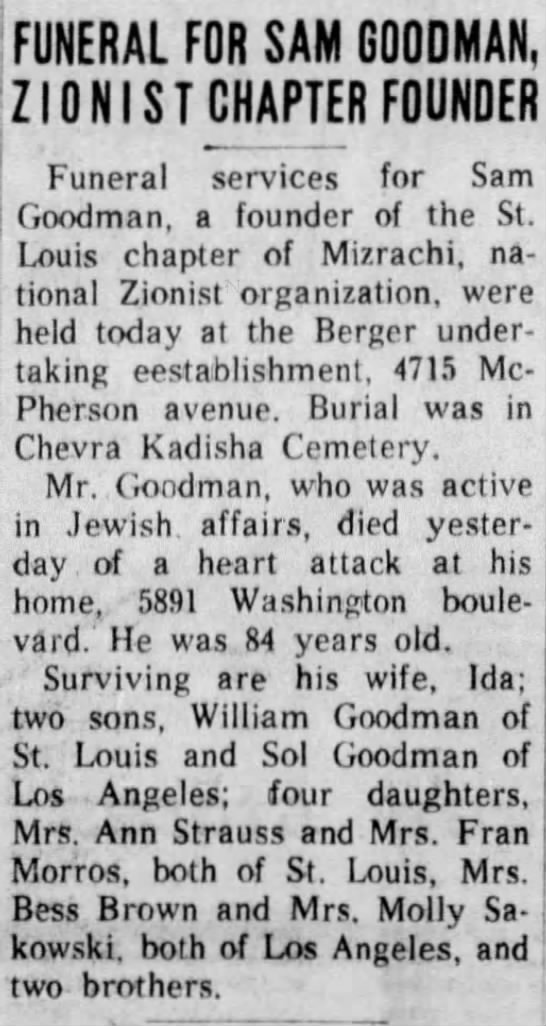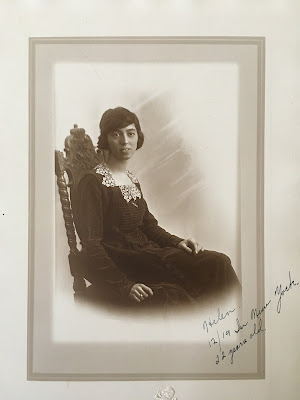Helen quit her first teaching position and is back at home, bored. After all the excitement of her senior year at Washington University and a trip to Colorado, these last months have been dull. Even her birthday does not deserve much attention in her diary.
September
Monday 22
Wash day again.
Tuesday 23
Received pictures & letters from Mae – she’s engaged
Wednesday 24
I was ironing today
Thursday 25
Ironing – party
Friday 26
I was pretty blue. Ida left for Portland.
Saturday 27
This was my birthday.
Sunday 28
Not much doing
Notes:
Sept. 26
Ida Goodman's address appears at the beginning of the diary as in Monument, KS. Helen wrote Ida a letter on April 10. On May 1, Helen wrote, "Ida is here! I drove over to see her. She's darling." On May 2, Helen wrote that Ida came for dinner and they stayed up until midnight talking. On June 29 and July 30, Ida also came to Helen's home.
I have not been able to pinpoint Helen's friend in the records.
Researching in The Jewish Voice on Newspapers.com, I discover an Ida Goodman was a Sabbath School teacher at Montefiore Congregation. There is an Ida Goodman married to the St. Louis Zionist Chapter founder Sam Goodman. There are lots of Ida Goodmans as a married name!

I found an August 1818 wedding of an Ida Goodman to a George Willis of Kansas City. But no Ida Goodman marrying in 1919!
In the news, there was a national steel strike involving riots and deaths; the ice dealers reported that cooler weather saved St. Louis from an "ice famine," the ice being depleted after a long, hot summer; and there were 2,000 dead from a hurricane striking Texas.
I noted this article in the Sept. 23, 1919, St. Louis Star and Times because Helen was friends with Florence Funston, mentioned in the diary on Jan. 8, 1919. The Funston Brothers were digging a foundation for a new building when a 'prison' was discovered.

Century-Old Cellar, Apparently a Slave Prison. Excavated Here Men Digging for Foundation of New Building at Fourth and Market Streets Find Sub-Cellar With Barred Window and Fire Place.
Excavation of ground at the southeast corner of Fourth and Market streets for the new eight-story building for Funsten Brothers & Company yesterday revealed a prison-like sub-cellar apparently constructed about 100 years ago when Broadway lit the western boundary of St. Louis.
The odd formation of the cellar, apparently unattached to any of the buildings that had surrounded or covered it lent color to the belief that it might have been a part of the old fort that was in the vicinity In the early days. This belief, however, Is not shared by Walter B. Douglas, vice president of the Missouri Historical Society.
The cellar was about 25 feet square, and lay about 50 feet east of the Fourth Street line and about 80 feet south of the south line of Market Street. It's walls excepting the south wall have been torn up to make way for the new $700,000 building for the fur exchange. The top part of the wall had been covered and an alleyway built over it.
About six feet from the eastern wall, apparently, was a flue that led upward from the basement, while five feet west of this was an iron-barred window about three feet square. Because of its prison-like appearance, it gave rise to the belief that it was the burial place of Pontiac, the Indian chief murdered at Cahokia, Ill., in 1769 and brought to St. Louis for burial by Gov. St. Ange de Belle-rive.
Mr. Douglas examined the excavation yesterday to find out whether there could be any connection between the cell-like basement and the famous Ottawa chief. "I came to the conclusion that the cellar, while very old. was constructed many years after Pontiac's death," said Douglas. "The bars, for instance, are of cast iron, and if they had been put in before Pontiac's death they would have been wrought iron. Apparently, the place was constructed for the slaves of St. Louis families. The fireplace to the left of the barred window shows that it was built with a view to habitation. In addition, the contractor tells me that the flooring was apparently of cobblestones."
Douglas said the cellar could not have had any connection with Pontiac's burial place, because, so far as he can learn, the spot where the Indian was burled was about seventy-five feet south of the south line of Market street halfway between Fourth Street and Broadway. He called attention to-the tablet to the Indian's memory on the left wall of the Broadway entrance to the Southern Hotel, which he said as placed there merely because it was the nearest available place to the grave. Nor could the building have been any part of the old fortification, which stood north of Elm Street between Broadway and Fourth Street and extended northward for about seventy-five feet north of Walnut street.
Douglas said that there was an old graveyard north of the old fortification for the burial of those who could not be Interred in the cemetery of the Catholic Church. Pontiac, not being a member of that church, consequently, was buried in the cemetery north of the fort, which would be south of Market Street between Fourth Street and Broadway.
The date of 1815 was fixed as the date of the building by Judge Douglas from the fact that the structure which originally covered it was of brick. The oldest brick building in St. Louis, according to Judge Douglas, was erected in 1813. He is of the opinion from the character of construction that the cellar was constructed some time afterward.
CLIPPED FROM
The St. Louis Star and Times
St. Louis, Missouri
23 Sep 1919, Tue • Page 3

No comments:
Post a Comment